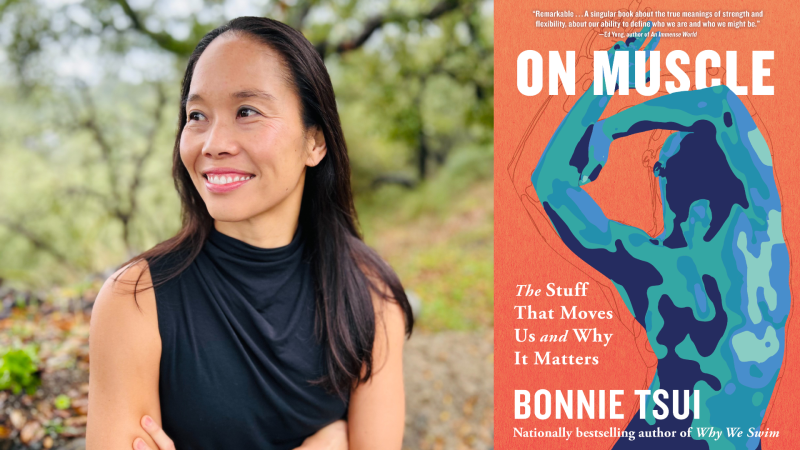We often take our muscles for granted, rarely stopping to consider just how complex and essential they are. From the powerful beat of our hearts to the tiny fibers that raise goosebumps, our muscles do far more than we realize. They don’t just follow instructions from the brain — they send signals back and even hold their own kind of memory. In her new book “On Muscle: The Stuff That Moves Us and Why It Matters,” journalist and author Bonnie Tsui offers a new way of looking at muscles, in terms of both their physicality and cultural significance. She joins us to discuss how reconsidering muscles can allow us to find deeper meaning in our understanding of strength, beauty and what it means to be human.
Bonnie Tsui on the Science, Symbolism and Strength of Muscle

Guests:
Bonnie Tsui, author and journalist, her latest book is "On Muscle: The Stuff That Moves Us and Why It Matters"
Forum is now on YouTube. Subscribe to the KQED News YouTube channel and watch the full interview.
Interview Highlights
Theme: The Importance and Complexity of Muscles
Muscles are often overlooked, yet they play an essential role in our daily lives, from the powerful beating of our hearts to the tiny fibers that raise goosebumps. As Bonnie Tsui explains, “There’s so much about them that we take for granted and don’t understand.” Muscles don’t merely follow instructions from the brain; they communicate back through chemical signals called myokines, which influence cognition, mood and even our emotional state. “It’s like a love letter from your muscle to your brain,” says Tsui.
Beyond their physical functions, muscles shape our cultural perceptions of strength, beauty and what it means to be human. “We imbue them with all kinds of virtues,” Tsui notes, citing phrases like “muscle through it” and “exhibit good form” that associate muscularity with positive qualities like resilience and leadership. However, this perception is not always equitable. Women face judgment when they’re seen as being “too muscular” because of lingering gender norms.
Theme: The Mind-Muscle Connection
Tsui explores the deep connection between our minds and muscles, emphasizing that this relationship is bidirectional. “Our muscle is an endocrine tissue,” she explains, sending signaling molecules throughout the body, including to the brain. This “muscle memory” is not just about motor patterns but involves cellular and epigenetic processes, where muscle cells retain memory of prior exercise, priming them for future activity.
Matthew Sanford, a renowned yoga teacher paralyzed from the chest down, exemplifies the power of the mind-muscle connection. Even with his paralysis, Sanford can feel subtle sensations and achieve a sense of alignment by engaging his whole body in certain poses, sometimes using assistance to move his legs. “Yoga is using your muscles in service to the whole,” Tsui quotes Sanford, highlighting the profound mind-body link.
Theme: Muscle Adaptability and Resilience
One of the most inspiring aspects of muscle is its remarkable adaptability, even into old age. Tsui cites a twin study where one sibling remained sedentary while the other continued running marathons, resulting in significantly different muscle fiber compositions by their fifties. “You’re born with what you’re born with, but you can do so much to improve your health at any age,” she emphasizes.
The way muscles grow stronger mirrors a philosophy of resilience: “The way you build muscle is by breaking yourself down. Muscle fibers sustain damage through strain and stress, then repair themselves by activating special stem cells that fuse to the fiber to increase size and mass. You get stronger by surviving each series of little breakdowns, allowing for regeneration, rejuvenation, regrowth.” This cycle of breaking down and rebuilding, Tsui suggests, can inspire us to embrace challenges beyond the physical realm.
Theme: Muscles and Aging
While age-related muscle loss (sarcopenia) is often inevitable, starting around the thirties and accelerating through the sixties, Tsui emphasizes the significant benefits of strength training for older adults. “If you’re in your seventies and you haven’t (exercised), start,” she advises. The body’s capacity for muscular adaptation remains high, potentially yielding substantial gains, no matter when one begins.
However, rapid weight loss through medications like Ozempic can accelerate muscle loss if not accompanied by proper nutrition and strength training. Tsui recommends weightlifting or other challenging exercises to retain and build muscle mass, which is linked to improved cardiovascular and cognitive health in later life.
Theme: The Joy of Communal Movement
Shared physical activity, whether through sports, dance or workouts, fosters powerful connections and transcends differences. As one caller attests, the bond between a personal trainer and client “is not one rooted in capitalism” but a dynamic rooted in mutual support and growth, often bridging political divides.
Tsui resonates with this sentiment, recalling her father’s martial arts studio as a space for “communal movement” and “collective joy.” Movements like jumping together, she explains, become “an expression of collective joy.” Such shared experiences highlight the deeply human need for connection through physical practice and can serve as a “love language” unto itself.
This content was edited by the Forum production team but was generated with the help of AI.